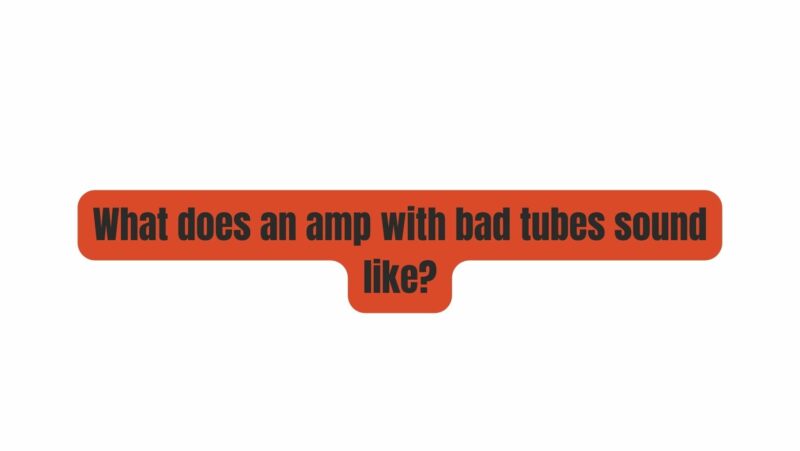Amplifiers are the lifeblood of any guitarist’s rig, and tube amplifiers, in particular, are revered for their warm, rich, and expressive tones. However, even the most beloved tube amps can run into trouble, and one of the most common issues is failing tubes. Tubes, also known as valves, play a pivotal role in shaping the amplifier’s sound. When they go bad, the consequences can be disheartening for any musician. In this article, we’ll explore what an amp with bad tubes sounds like, helping you diagnose and address this common problem to keep your musical gear in tip-top shape.
Understanding the Basics: Tubes in Amplifiers
Before diving into the sonic symptoms of bad tubes, let’s briefly understand the importance of tubes in amplifiers. Tube amplifiers use vacuum tubes (also known as electron tubes or thermionic valves) to amplify the audio signal. These tubes contain electrodes, and when heated, they emit electrons, creating an electric current that amplifies the incoming guitar signal. Tubes are often favored for their unique sonic characteristics, including harmonically rich distortion and smooth compression.
The Telltale Signs of Bad Tubes: What to Listen For
- Loss of Clarity and Definition: One of the earliest signs of failing tubes is a noticeable loss of clarity and definition in your amplifier’s sound. You may notice that the once-pristine clean tones become muddier and less articulate. The distortion, if present, might become less controlled and more chaotic.
- Unwanted Noise and Hiss: Bad tubes can introduce unwanted noise into your signal path. This can manifest as a constant hiss, crackling sounds, or intermittent popping. These noises are typically more pronounced when you’re not playing your guitar, indicating an issue with the tubes rather than external interference.
- Reduced Output and Volume: As tubes deteriorate, they often lose their ability to produce the same level of output. This results in a noticeable drop in overall volume. You may find yourself cranking the amp higher than usual to achieve the same level of volume you’re accustomed to.
- Inconsistent Performance: Another characteristic of failing tubes is inconsistent performance. You might experience fluctuations in tone, volume, or overall sound quality during a single playing session. This unpredictability can be frustrating and is a strong indicator of tube issues.
- Increased Hum and Buzz: Amplifier tubes, when functioning correctly, should be relatively quiet. However, bad tubes can introduce a noticeable hum or buzz into your signal, especially when the volume is turned up. This interference can be distracting and compromise your playing experience.
- Loss of Dynamics and Responsiveness: Tube amplifiers are known for their dynamic response, where they react to your playing style and the nuances of your guitar. Bad tubes can rob your amp of this dynamic quality, making your playing feel less responsive and less expressive.
- Excessive Microphonic Feedback: Microphonic feedback occurs when the tubes pick up vibrations and convert them into audible sounds. Failing tubes are more prone to microphonic feedback, resulting in squeals or howls when you tap the amp or move it.
- Tonal Changes: Perhaps the most significant sign of bad tubes is the alteration of your amp’s tone. You may notice a shift in the overall tonal character, with a loss of warmth, richness, or harmonic complexity that you once enjoyed. This can be particularly distressing for musicians who cherish their amp’s unique sonic signature.
Diagnosing the Issue: How to Identify Bad Tubes
Now that we’ve covered the auditory symptoms of bad tubes, it’s essential to know how to diagnose the problem. Here are some steps to help you identify which tubes might be causing the issues:
- Visual Inspection: Inspect the tubes for any signs of physical damage or discoloration. Burned-out tubes may have a blackened or white, powdery appearance.
- Swap Tubes: If you suspect a specific tube is faulty, try swapping it with a known-good tube of the same type and see if the problem persists. This can help isolate the issue to a particular tube.
- Use a Tube Tester: A tube tester is a specialized device that can measure a tube’s performance and help identify bad tubes. If you have access to one, it can be a valuable tool for diagnostics.
- Consult a Technician: If you’re unsure or uncomfortable with tube replacement, it’s always wise to consult a qualified amplifier technician. They can diagnose and replace faulty tubes with precision.
Conclusion: Preserving Your Tube Amp’s Sonic Excellence
A tube amplifier with bad tubes may sound drastically different from its optimal state, exhibiting symptoms like loss of clarity, increased noise, reduced volume, and inconsistent performance. Recognizing these sonic signs is crucial for preserving your amplifier’s sonic excellence and avoiding further damage. Regular maintenance and tube replacement when necessary are key to keeping your beloved tube amp in top-notch condition. With proper care, your amp can continue to deliver those iconic tube-driven tones for years to come, ensuring that your music always shines at its best.

